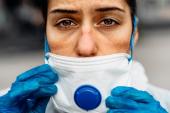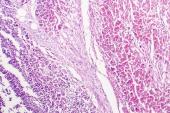COVID-19: TCTMD’s Daily Dispatch for September Week 3
We’re curating a list of COVID-19 research and other useful content, and updating it regularly.

Since March 2020, TCTMD reporter Todd Neale has been writing up breaking news and peer-reviewed research related to COVID-19 every weekday. In July 2021, we transitioned to Mondays, Wednesdays, and Fridays. If you have something to share, tell us. All of our COVID-19 coverage can be found on our COVID-19 Hub.
September 17, 2021
 Around the globe, weekly COVID-19 numbers dropped for the first time in more than 2 months, according to the latest update from the World Health Organization (WHO). Still, as noted by CIDRAP News, there were nearly 4 million new cases and 62,000 deaths reported. Only a few countries recorded increases in infections, with the biggest jumps over the previous week seen in Nigeria (by 90%) and Ecuador (by 72%). The WHO’s COVID-19 technical lead said on Twitter about the global situation, “This is far, far, far too many cases and deaths when we have tools to prevent them.”
Around the globe, weekly COVID-19 numbers dropped for the first time in more than 2 months, according to the latest update from the World Health Organization (WHO). Still, as noted by CIDRAP News, there were nearly 4 million new cases and 62,000 deaths reported. Only a few countries recorded increases in infections, with the biggest jumps over the previous week seen in Nigeria (by 90%) and Ecuador (by 72%). The WHO’s COVID-19 technical lead said on Twitter about the global situation, “This is far, far, far too many cases and deaths when we have tools to prevent them.”
A US Food and Drug Administration advisory committee is meeting Friday to discuss the data around COVID-19 vaccine booster shots, specifically as it pertains to the application for use of a third dose from Pfizer and BioNTech. A link to the livestream on YouTube can be found here. Reporters from STAT, who are live-blogging the meeting, say that “in regulatory terms, the [Biden] administration put the cart well out in front of the horse when it declared in August that a national campaign to administer third shots would begin the week of Sept. 20—that’s next week—before the FDA had approved the Pfizer application and before the other two manufacturers supplying the United States had applied for the right to market a booster.”
CIDRAP News provides a roundup of recent research showing that protection against infection remains high, but reduced, 6 months after a second vaccine dose, with boosters associated with increased vaccine efficacy. For example, one study from Israel, published in the New England Journal of Medicine, shows that 12 days after a third dose, the infection rate was 11.3 times lower than in a control group.
News from around the world: Singapore reported 935 new COVID-19 cases on Friday, which was the highest total since near the beginning of the pandemic in April 2020 (Reuters); Cuba has started vaccinating children ages 2 to 10 with homegrown shots (AP); the Netherlands will require proof of vaccination or a recent negative SARS-CoV-2 test for entry into bars, restaurants, museums, and other sites starting September 25 (Reuters); Italy has extended its COVID-19 pass (proof of vaccination, recovery from the disease, or testing every 2 days) to cover most workers in public and private companies (New York Times); and Cambodia has started vaccinating children ages 6 to 11 before schools reopen (AP).
Results of DisCoVeRy trial of remdesivir in COVID now out. No significant effect of remdesivir on death, other clinical outcomes or viral kinetics. Big question about the role of this drug. https://t.co/6WUfMQtb5i
— Peter Horby (@PeterHorby) September 17, 2021
Results from the European DisCoVeRy trial—published this week in the Lancet Infectious Diseases—show that adding remdesivir (Veklury; Gilead Sciences) to standard of care did not improve clinical outcomes in patients hospitalized with COVID-19 who were symptomatic for more than 7 days and required oxygen support, calling into question the widespread use of the antiviral during the pandemic. Peter Horby, MD, PhD, one of the leaders of the RECOVERY trial program in the UK, tweeted: “Big question about the role of this drug.”
The mRNA vaccines may have an edge over the single-shot Janssen vaccine from Johnson & Johnson when it comes to preventing COVID-19 hospitalizations in adults without immunocompromising conditions, data from Morbidity and Mortality Weekly Report (MMWR) suggest. Between March 11 and August 15, 2021, vaccine effectiveness was 93% with Moderna’s shot, 88% with the Pfizer/BioNTech vaccine, and 71% with the Janssen vaccine from Johnson & Johnson. “Although these real-world data suggest some variation in levels of protection by vaccine, all FDA-approved or authorized COVID-19 vaccines provide substantial protection against COVID-19 hospitalization,” the authors note.
Another study in MMWR indicates that the rate of increase in body mass index among US children and adolescents roughly doubled during the pandemic compared with pre-COVID times, with the greatest accelerations seen among those who were already overweight or obese and younger children. The estimated rate of obesity in this cohort increased from 19.3% in August 2019 to 22.4% a year later.
The safety committee of the European Medicines Agency (EMA) concluded its review on the risk of thrombosis with thrombocytopenia syndrome (TTS) associated with the Oxford/AstraZeneca vaccine. “Although spontaneous reports when put in relation to the exposure have suggested that the risk may be higher in women and in younger adults, and lower after the second compared to the first dose, the limitations of the way the data is collected mean that none of these differences could be confirmed,” the group said, noting that there’s no evidence that delaying the second dose affects TTS risk.
Factors associated with hospitalization for COVID-19 among children and adolescents include private insurance, obesity/type 2 diabetes, asthma, cardiovascular disease, an immunocompromised condition, pulmonary disease, and neurologic disease, according to a study published in the Journal of Hospital Medicine. Disease severity was greater among non-white patients.
 Continuing waves of COVID-19 have hampered the American Heart Association’s plan to have at least some in-person events in Boston, MA, as part of its annual meeting, which is scheduled for November 13 to 15. The AHA announced this week that its Scientific Sessions will be a completely virtual event. TCTMD’s Michael O’Riordan has the story.
Continuing waves of COVID-19 have hampered the American Heart Association’s plan to have at least some in-person events in Boston, MA, as part of its annual meeting, which is scheduled for November 13 to 15. The AHA announced this week that its Scientific Sessions will be a completely virtual event. TCTMD’s Michael O’Riordan has the story.
September 15, 2021
 COVID-19 cases among children continue to rise, according to the latest report from the American Academy of Pediatrics (AAP). As of September 9, nearly 5.3 million children have tested positive for SARS-CoV-2 since the beginning of the pandemic, including more than 243,000 in the past week. That’s the second-highest weekly total thus far. “After declining in early summer, child cases have increased exponentially, with nearly 500,000 cases in the past 2 weeks,” the AAP notes. Data from the Israeli health ministry indicate that 11% of kids infected with the virus have lingering symptoms, or long COVID (Times of Israel).
COVID-19 cases among children continue to rise, according to the latest report from the American Academy of Pediatrics (AAP). As of September 9, nearly 5.3 million children have tested positive for SARS-CoV-2 since the beginning of the pandemic, including more than 243,000 in the past week. That’s the second-highest weekly total thus far. “After declining in early summer, child cases have increased exponentially, with nearly 500,000 cases in the past 2 weeks,” the AAP notes. Data from the Israeli health ministry indicate that 11% of kids infected with the virus have lingering symptoms, or long COVID (Times of Israel).
The increasing number of children with COVID-19 mirrors the surge in the US population overall, which has brought numbers of cases and deaths back to levels not seen since last winter, the Associated Press reports. The South is being hardest hit, with the New York Times reporting that the number of people receiving treatment for COVID-19 in ICUs across the region has reached “crisis levels.” Roughly one-quarter of hospitals—up from about one-fifth last month—are saying that more than 95% of their ICU beds are occupied. “Experts say it can become difficult to maintain standards of care for the sickest patients in hospitals where all or nearly all ICU beds are occupied.” The situation is particularly dire in Alabama, where all ICU beds are currently being used.
Most allogeneic hematopoietic stem cell transplant recipients (83%) had an antibody response to two doses of the Pfizer/BioNTech COVID-19 vaccine, according to a study in JAMA Network Open. “This humoral response is, however, only one marker of immunity, and allogeneic HSCT recipients will likely have differences in T cell reactivity that should be explored,” the researchers say.
 A Kaiser Family Foundation (KFF) report published Tuesday shows that the costs associated with preventable COVID-19 hospitalizations among unvaccinated adults continues to climb. Estimated costs were $600 million in June, $1.4 billion in July, and $3.7 billion in August, for a total of $5.7 billion in those 3 months. “The monetary cost of treating unvaccinated people for COVID-19 is borne not only by patients but also by society more broadly, including taxpayer-funded public programs and private insurance premiums paid by workers, businesses, and individual purchasers,” the authors highlight.
A Kaiser Family Foundation (KFF) report published Tuesday shows that the costs associated with preventable COVID-19 hospitalizations among unvaccinated adults continues to climb. Estimated costs were $600 million in June, $1.4 billion in July, and $3.7 billion in August, for a total of $5.7 billion in those 3 months. “The monetary cost of treating unvaccinated people for COVID-19 is borne not only by patients but also by society more broadly, including taxpayer-funded public programs and private insurance premiums paid by workers, businesses, and individual purchasers,” the authors highlight.
The onset of the pandemic led many women to rethink their pregnancy plans, a study in JAMA Network Open shows. Among women in New York City who had young children, nearly half of those who had been trying to get pregnant again, and more than one-third of those who were thinking about it, stopped in the first few months of the COVID-19 crisis. The authors note that “increased stress and financial insecurity owing to the COVID-19 pandemic paralleled a reduction in pregnancy intention in the early months of the pandemic, potentially exacerbating long-term decreases in the fertility rate.”
Several data briefs from the Agency for Healthcare Research and Quality’s (AHRQ) Healthcare Cost and Utilization Project (HCUP)—covering all ages, pediatric patients, adults ages 18 to 64, and adults ages 65 and older—provide insights into hospitalization patterns during the first several months of the pandemic. Between April and September, the proportions of hospitalizations and deaths attributed to COVID-19 were 5% and 27%, respectively. The number of in-hospital deaths more than doubled for Hispanic patients and rose by 60% for non-Hispanic Black patients compared with the same time period in previous years.
A news feature in Nature tackles the complicated history of mRNA vaccines, which can be traced back to experiments performed by Robert Malone, MD, in 1987. This technology has now been used to create effective COVID-19 vaccines, and Malone, “who calls himself the ‘inventor of mRNA vaccines’, thinks his work hasn’t been given enough credit. ‘I’ve been written out of history,’ he told Nature.”
 Several Broadway shows—including Hamilton—have reopened at full capacity, with requirements that audience members show proof of vaccination and wear masks, CBS News reports. “Throughout New York’s theater district, you can literally see signs indicating that Broadway is coming back to life. It's a crucial return for New York, not just as an art form, but also as an economic engine.”
Several Broadway shows—including Hamilton—have reopened at full capacity, with requirements that audience members show proof of vaccination and wear masks, CBS News reports. “Throughout New York’s theater district, you can literally see signs indicating that Broadway is coming back to life. It's a crucial return for New York, not just as an art form, but also as an economic engine.”
September 13, 2021
 Current evidence does not support giving COVID-19 vaccine boosters to the general population, researchers conclude in a review published in the Lancet. “The limited supply of these vaccines will save the most lives if made available to people who are at appreciable risk of serious disease and have not yet received any vaccine,” according to the authors, who include scientists from the US Food and Drug Administration (FDA) and the World Health Organization (WHO). “Even if some gain can ultimately be obtained from boosting, it will not outweigh the benefits of providing initial protection to the unvaccinated. If vaccines are deployed where they would do the most good, they could hasten the end of the pandemic by inhibiting further evolution of variants.” This stance is consistent with the WHO’s call for a moratorium on the use of boosters.
Current evidence does not support giving COVID-19 vaccine boosters to the general population, researchers conclude in a review published in the Lancet. “The limited supply of these vaccines will save the most lives if made available to people who are at appreciable risk of serious disease and have not yet received any vaccine,” according to the authors, who include scientists from the US Food and Drug Administration (FDA) and the World Health Organization (WHO). “Even if some gain can ultimately be obtained from boosting, it will not outweigh the benefits of providing initial protection to the unvaccinated. If vaccines are deployed where they would do the most good, they could hasten the end of the pandemic by inhibiting further evolution of variants.” This stance is consistent with the WHO’s call for a moratorium on the use of boosters.
In a roundup of news about efforts to control the pandemic around the world, the lockdown in Auckland, New Zealand, has been extended to September 21 to control the spread of the Delta variant (Reuters); the Chinese city of Putian has asked its 2.9 million residents to stay put while suspending bus and train service and closing movie theaters, bars, and other facilities (AP); Japan has topped 50% vaccination coverage and is looking at easing restrictions in November (AP); and Vietnam is accelerating its vaccination efforts with the aim of lifting some of its lockdowns in major cities by the end of the month (AP).
On Monday, Australia started vaccinating children as young as 12 with the Pfizer/BioNTech shot, the New York Times reports. The Moderna vaccine will be available starting next week. “Australia’s vaccine campaign is gaining speed after a sluggish first few months. Millions of doses that were ordered earlier this year are arriving, and the country will have enough supply by mid-October to vaccinate every eligible person, Prime Minister Scott Morrison said last week.” It looks like similar efforts will be coming to the United Kingdom, as British officials said Monday that children ages 12 to 15 should be vaccinated, the AP reports.
 Between March and May, when the Delta variant was spreading rapidly around the United Kingdom, nearly one-third of people (more than 300,000) arriving in England and Northern Ireland may have broken quarantine rules, BBC News reports. However, the government couldn’t say how many of these instances, reported to investigators, were found to involve broken rules or couldn’t be traced.
Between March and May, when the Delta variant was spreading rapidly around the United Kingdom, nearly one-third of people (more than 300,000) arriving in England and Northern Ireland may have broken quarantine rules, BBC News reports. However, the government couldn’t say how many of these instances, reported to investigators, were found to involve broken rules or couldn’t be traced.
Numbers of COVID-19 cases and deaths in US nursing homes may be much higher than federal data indicate, according to a study in JAMA Network Open. Researchers report that “approximately 44% of COVID-19 cases and 40% of COVID-19 deaths that occurred before the start of reporting were not reported in the first National Healthcare Safety Network submission in sample states, suggesting there were more than 68,000 unreported cases and 16,000 unreported deaths nationally.” An invited commentary notes that this limitation needs to be taken into account in future studies using this data set. “The second, more-humbling conclusion from these findings is that the true toll of COVID-19 on nursing home residents may never be known,” writes Elizabeth White, PhD, APRN.
On Friday, Becker’s Hospital Review pointed out that the 7-day average for new COVID-19 cases in the United States dropped last week for the first time since June 25. The average (136,558) “is 46.2% lower than the pandemic's highest average (254,016) recorded January 10, and 1,076% higher than the lowest average of 2021 (11,613), recorded June 18,” the site notes. The hospitalization average also fell, by 4.1%.
 Thirteen gorillas at Zoo Atlanta tested positive for SARS-CoV-2 after developing symptoms, including coughing, nasal discharge, and minor changes in appetite, the Atlanta-Journal Constitution reports. The zoo said it is treating the some of the gorillas with monoclonal antibodies, adding that it’s believed the animals caught the virus from a fully vaccinated and asymptomatic member of the care team.
Thirteen gorillas at Zoo Atlanta tested positive for SARS-CoV-2 after developing symptoms, including coughing, nasal discharge, and minor changes in appetite, the Atlanta-Journal Constitution reports. The zoo said it is treating the some of the gorillas with monoclonal antibodies, adding that it’s believed the animals caught the virus from a fully vaccinated and asymptomatic member of the care team.
Todd Neale is the Associate News Editor for TCTMD and a Senior Medical Journalist. He got his start in journalism at …
Read Full Bio





Comments